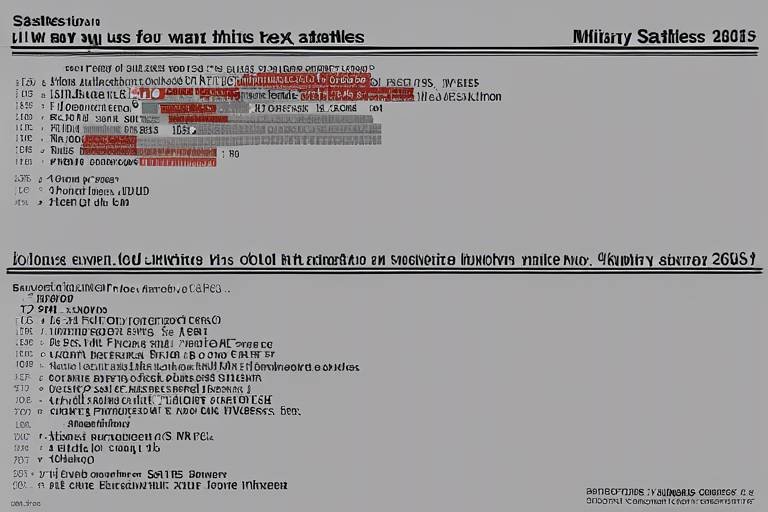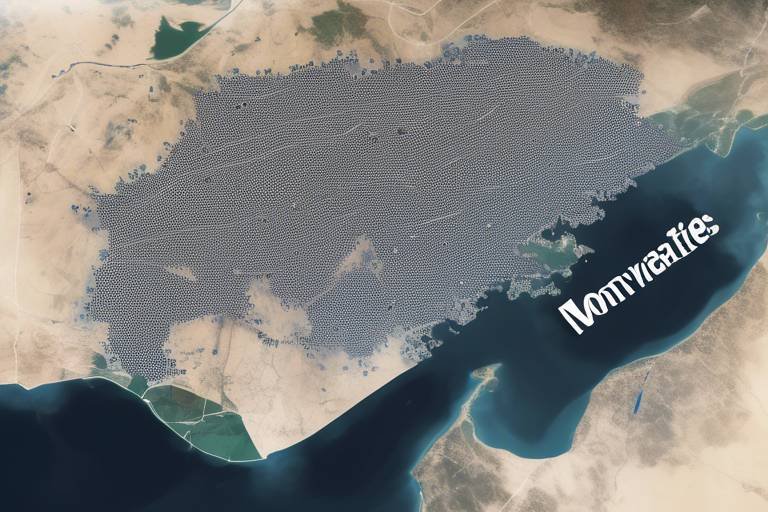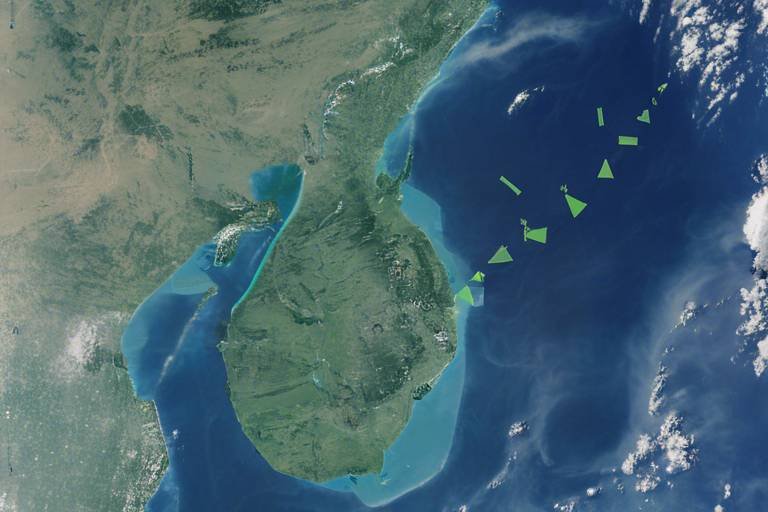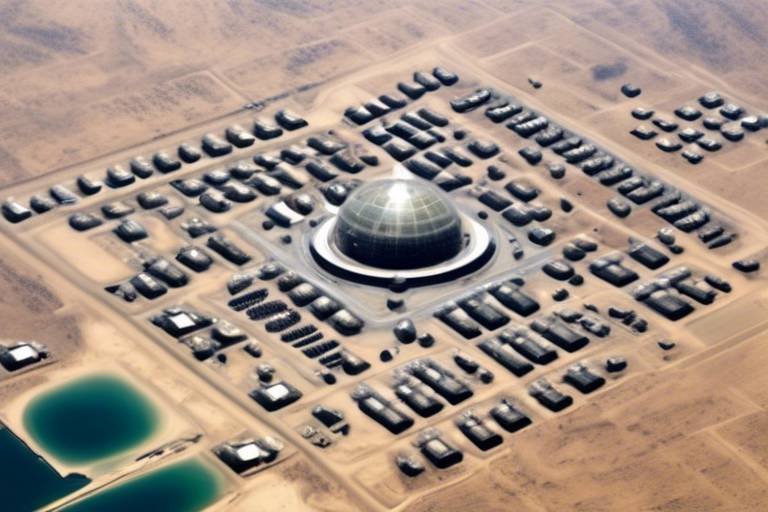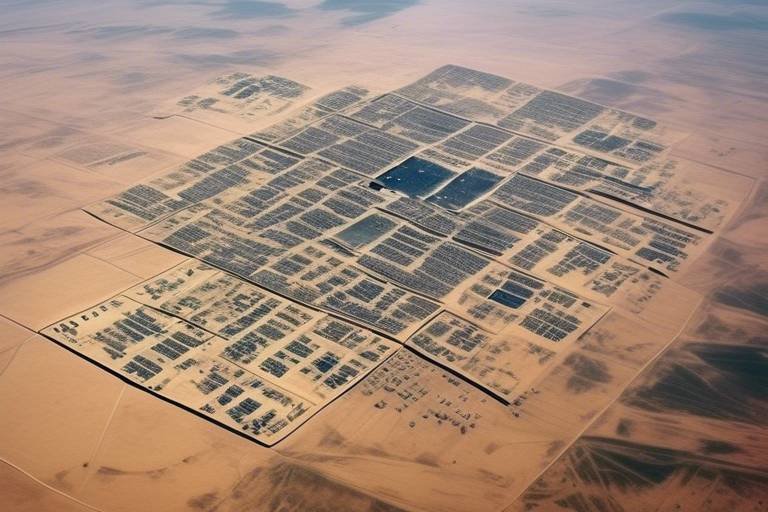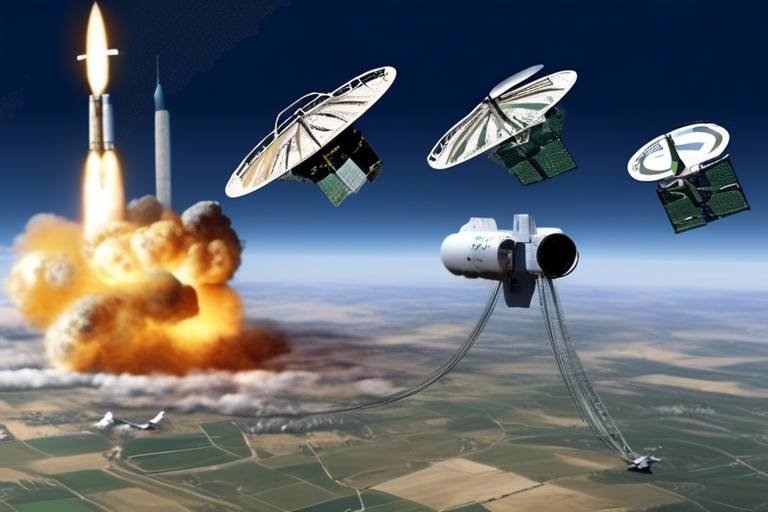The Evolution of Military Satellites - From Cold War to Modern Warfare
The landscape of warfare has undergone a dramatic transformation over the decades, and at the heart of this evolution lies the development of military satellites. From their humble beginnings during the Cold War to the sophisticated systems we see today, military satellites have become indispensable tools for nations around the world. They have not only redefined how conflicts are fought but have also significantly enhanced national security and strategic planning. This article delves into the journey of military satellites, highlighting their pivotal role in shaping modern warfare and defense strategies.
The inception of military satellites during the Cold War marked a pivotal moment in defense technology. These satellites provided nations with enhanced surveillance capabilities and strategic advantages in global conflicts. The era was characterized by intense rivalry between superpowers, with each side striving to outmaneuver the other not just on land and sea, but also in the skies. The launch of the first military satellites was akin to a technological arms race, where the stakes were incredibly high. Countries realized that having eyes in the sky would offer them a distinct edge in gathering intelligence and monitoring enemy movements.
During the Cold War, several key satellites were launched that played crucial roles in intelligence gathering. Programs like CORONA and GAMBIT were groundbreaking, offering unprecedented capabilities in photographic reconnaissance. These satellites allowed for the collection of high-resolution images of enemy territories, which significantly influenced the balance of power between the superpowers. The intelligence gathered from these satellites was often the difference between victory and defeat, making them invaluable assets in the military arsenal.
The advent of surveillance satellites revolutionized reconnaissance. For the first time, military planners could access real-time imagery and data, enabling them to make informed decisions and assess enemy movements with unprecedented accuracy. Imagine having a bird's-eye view of enemy positions while sitting in a command center thousands of miles away. This capability not only enhanced situational awareness but also allowed for rapid response to emerging threats.
As technology progressed, so did the capabilities of military satellites. The evolution of sensor technology led to improvements that allowed for higher resolution images and enhanced data collection. These advancements became essential for national security and military operations, enabling forces to monitor vast areas with remarkable detail. The integration of advanced imaging techniques, such as synthetic aperture radar (SAR), further pushed the boundaries of what was possible in satellite surveillance.
The availability of satellite data transformed military strategies across the globe. Commanders could now rely on precise intelligence to shape operations and deploy resources effectively. The ability to anticipate enemy movements and respond swiftly became a game-changer, altering the very fabric of military planning. In essence, the reliance on satellite intelligence meant that wars could be fought with a level of precision previously thought impossible.
In addition to surveillance, military satellites enhanced communication and navigation. Troops in the field could remain connected to command centers, ensuring that they had access to vital information at all times. Accurate navigation became critical, especially in unfamiliar territories where traditional maps might fall short. The integration of Global Positioning System (GPS) technology into military operations has proven to be a vital component for mission success, allowing forces to coordinate movements and execute strategies with pinpoint accuracy.
As we moved into the contemporary era, military satellites evolved to include advanced capabilities such as missile warning systems, electronic warfare, and integrated defense networks. These developments reflect the complexities of modern warfare, where threats are multifaceted and constantly evolving. The role of satellites has expanded beyond mere observation; they now play an integral part in proactive defense strategies.
Modern military satellites often involve collaboration among allied nations. This sharing of intelligence and resources strengthens collective security and enhances response capabilities in a rapidly changing global landscape. Countries are increasingly recognizing that in an interconnected world, collaboration is key to addressing shared threats. This multinational approach not only fosters better relationships but also amplifies the effectiveness of military operations.
Despite their numerous advantages, military satellites face significant challenges. Cyber threats and anti-satellite weapons pose serious risks, prompting ongoing investments in security measures and resilient satellite systems to safeguard national interests. The vulnerability of these systems has led to a renewed focus on developing countermeasures and ensuring that satellite networks remain operational in the face of potential attacks. As we look to the future, the importance of protecting these assets cannot be overstated.
- What are military satellites used for? Military satellites are primarily used for surveillance, reconnaissance, communication, and navigation.
- How have military satellites changed over time? They have evolved from basic surveillance tools to advanced systems capable of missile warning, electronic warfare, and integrated defense.
- What are the risks associated with military satellites? They face challenges such as cyber threats, anti-satellite weapons, and the need for constant security updates.
- Why is multinational collaboration important in military satellite operations? Collaboration enhances collective security and strengthens response capabilities to shared threats.
The Birth of Military Satellites
The inception of military satellites during the Cold War marked a pivotal moment in defense technology, fundamentally altering the landscape of global conflict. Imagine the world in the 1960s, a time when tensions between superpowers were at an all-time high, and the need for reliable intelligence was paramount. The launch of the first military satellites was not just a technological leap; it was a game-changer that provided nations with enhanced surveillance capabilities and strategic advantages. These satellites served as the eyes in the sky, enabling countries to monitor troop movements, assess threats, and gather crucial data that would influence military strategies.
At the heart of this transformation were several key programs developed by the United States and the Soviet Union. The CORONA program, for instance, was the first series of reconnaissance satellites designed to capture high-resolution images of enemy territory. Launched in 1960, CORONA utilized film-based technology to collect imagery that was then returned to Earth in capsules. This innovation not only provided invaluable information but also laid the groundwork for future satellite missions. Similarly, the GAMBIT program, which followed CORONA, enhanced imaging capabilities and further refined the art of aerial reconnaissance.
These early military satellites were equipped with cutting-edge technology for their time. The ability to capture detailed photographs from space offered a level of surveillance that was previously unimaginable. As the Cold War progressed, the importance of these satellites became increasingly evident. They allowed military planners to make informed decisions based on real-time data, significantly influencing the balance of power between superpowers. The stakes were high, and the information gathered from these satellites was crucial for national security.
Moreover, the birth of military satellites was not just about gathering intelligence; it was also about sending a clear message to adversaries. The mere existence of these satellites acted as a deterrent, showcasing technological prowess and strategic capabilities. Nations understood that possessing such technology could shift the dynamics of power, making military satellites an integral part of defense strategies. As we look back at this era, it’s fascinating to see how the seeds planted during the Cold War have blossomed into the sophisticated satellite systems we rely on today.
In conclusion, the birth of military satellites was a landmark achievement that revolutionized warfare and defense strategies. These technological marvels provided nations with the tools they needed to navigate the complexities of global conflict. The legacy of early military satellites continues to influence modern military operations, demonstrating that the past is often the foundation upon which the future is built.
Key Cold War Satellites
The Cold War era was a time of intense rivalry and technological advancement, particularly in the realm of military satellites. During this period, several key satellites emerged that not only transformed the landscape of military intelligence but also played a crucial role in shaping global power dynamics. Among these, the CORONA and GAMBIT programs stand out as groundbreaking initiatives that significantly influenced the balance of power between the United States and the Soviet Union.
The CORONA program, launched in the 1960s, was the first successful series of reconnaissance satellites. It was designed to capture high-resolution images of enemy territories, which were then developed and analyzed to provide critical intelligence. Imagine being able to look over the fence at your rival's backyard; that's precisely what CORONA allowed military planners to do. With its ability to gather vast amounts of visual data, CORONA provided insights that were previously unattainable through traditional espionage methods.
Following closely was the GAMBIT program, which took satellite reconnaissance to the next level. Launched in the mid-1960s, GAMBIT utilized advanced camera technology to produce even sharper images than CORONA. This program was a game-changer, as it allowed for detailed surveillance of military installations and troop movements. The data collected from GAMBIT satellites was so precise that it could inform military strategies and operations, making it a vital tool in the United States' defense arsenal.
Furthermore, these satellites were not just about gathering intelligence; they also served as psychological tools. The mere existence of these surveillance capabilities deterred potential adversaries, as they knew their actions were being monitored. This aspect of satellite technology introduced a new dimension to military strategy, where the threat of observation could influence the decision-making processes of rival nations.
| Satellite Program | Launch Year | Primary Function |
|---|---|---|
| CORONA | 1960 | Reconnaissance and Surveillance |
| GAMBIT | 1963 | High-Resolution Imaging |
In summary, the key satellites of the Cold War, particularly CORONA and GAMBIT, were instrumental in shaping military strategy and intelligence gathering. They not only provided invaluable data but also influenced the psychological landscape of international relations. As we look back on this pivotal period, it’s clear that these technological advancements laid the groundwork for the sophisticated satellite systems we rely on today.
- What was the primary purpose of Cold War satellites?
Cold War satellites were primarily designed for reconnaissance and intelligence gathering, allowing nations to monitor military activities and assess threats. - How did CORONA and GAMBIT differ?
CORONA was the first successful reconnaissance satellite, while GAMBIT improved upon its predecessor by offering higher resolution images for more detailed surveillance. - What impact did these satellites have on military strategy?
The data collected from these satellites allowed military planners to make informed decisions, shaping operations and strategies based on real-time intelligence.
Surveillance and Reconnaissance
The advent of surveillance satellites during the Cold War was nothing short of revolutionary. These high-tech marvels changed the game in military strategy, allowing for real-time imagery and data collection that was previously unimaginable. Imagine being able to see enemy troop movements from thousands of miles away, as if you had a bird's eye view of the battlefield. This capability not only provided a tactical edge but also instilled a sense of security among military planners, knowing they had access to critical information at their fingertips.
With satellites like CORONA and GAMBIT leading the charge, the ability to gather intelligence became a cornerstone of military operations. These satellites captured images of enemy installations, troop deployments, and even missile sites, enabling commanders to make informed decisions. The data collected was meticulously analyzed, providing insights that shaped military strategies and influenced the outcomes of conflicts. The importance of this information can’t be overstated; it was the difference between victory and defeat in many instances.
Moreover, the advancements in sensor technology over the years have only enhanced the capabilities of surveillance satellites. Early models were limited in resolution and data processing power, but today’s satellites can capture stunningly detailed images, allowing analysts to discern even the smallest details. For example, modern reconnaissance satellites can identify the make and model of vehicles, track movements, and assess the readiness of enemy forces. This level of detail is crucial for national security and military operations, providing a comprehensive picture of the battlefield.
To illustrate the transformative impact of these technologies, consider the following table that highlights the evolution of satellite capabilities over the decades:
| Decade | Satellite Name | Key Features |
|---|---|---|
| 1960s | CORONA | First successful reconnaissance satellite with film-based imaging. |
| 1970s | GAMBIT | High-resolution imagery and advanced film recovery systems. |
| 1980s | Keyhole (KH) | Electro-optical imaging and improved data transmission. |
| 2000s | WorldView-1 | Commercial satellite with sub-meter resolution. |
| Present | GeoIQ | Real-time data processing and integration with AI analytics. |
As we move forward, the impact of satellite surveillance on military strategy cannot be overstated. Commanders now have the ability to rely on precise intelligence, shaping their operations and deploying resources effectively. The era of guesswork is over; with the right data, military leaders can predict enemy actions and respond accordingly. This capability has fundamentally altered the landscape of warfare, making it more dynamic and complex.
In conclusion, surveillance and reconnaissance satellites have become indispensable tools in modern military operations. They not only provide critical intelligence but also enhance the overall effectiveness of military strategies, allowing nations to maintain a competitive edge in an ever-evolving global landscape.
- What are military satellites used for?
Military satellites are primarily used for surveillance, reconnaissance, communication, and navigation. They play a crucial role in gathering intelligence and ensuring operational success. - How have military satellites evolved over time?
Military satellites have evolved from simple film-based imaging systems to advanced digital platforms capable of real-time data processing and high-resolution imagery. - What are the challenges faced by military satellites today?
Modern military satellites face challenges such as cyber threats, anti-satellite weapons, and the need for constant upgrades to remain effective in a rapidly changing technological landscape.
Technological Advancements
The landscape of military satellites has undergone a profound transformation, primarily driven by that have redefined their capabilities. In the early days of satellite technology, the focus was largely on basic imagery and data collection. However, as the demands of modern warfare evolved, so did the technology behind these satellites. Today, we witness an impressive array of sophisticated sensors and systems that not only enhance surveillance but also improve the speed and accuracy of data transmission.
One of the most significant advancements has been in the realm of sensor technology. Modern satellites are equipped with high-resolution imaging systems that can capture detailed images of the Earth's surface, even from thousands of miles away. For instance, the introduction of synthetic aperture radar (SAR) allows satellites to see through clouds and darkness, providing critical insights regardless of weather conditions. This capability is akin to having a pair of superhuman eyes that can pierce through the fog of war, offering clarity and understanding in chaotic environments.
Moreover, the integration of multi-spectral and hyperspectral imaging has revolutionized how military planners assess potential threats. These technologies enable the detection of specific materials and changes in the environment, allowing for more informed decision-making. Imagine being able to identify a hidden military installation simply by analyzing the chemical signatures emitted from the ground. This level of precision in reconnaissance was unimaginable a few decades ago.
Another critical advancement is the development of data processing algorithms that utilize artificial intelligence (AI) and machine learning. These algorithms can analyze vast amounts of data in real-time, identifying patterns and anomalies that human analysts might miss. This capability not only speeds up the intelligence-gathering process but also enhances the accuracy of the information provided to military commanders. It’s like having a team of highly skilled analysts working around the clock, tirelessly sifting through data to provide actionable insights.
Furthermore, advancements in communication technology have led to the establishment of secure and robust networks that connect military satellites with ground forces. This connectivity is crucial for mission success, as it ensures that troops have access to real-time data and can communicate effectively, even in the most challenging environments. The ability to relay information instantaneously can mean the difference between success and failure in military operations.
To summarize the evolution of technology in military satellites, consider the following table that highlights key advancements:
| Technology | Advancement | Impact |
|---|---|---|
| Synthetic Aperture Radar (SAR) | Ability to see through clouds and darkness | Enhanced surveillance capabilities |
| Multi-spectral Imaging | Detect specific materials and environmental changes | Improved threat assessment |
| AI and Machine Learning | Real-time data analysis | Faster, more accurate intelligence |
| Advanced Communication Systems | Secure, robust satellite-ground connections | Enhanced operational coordination |
In conclusion, the technological advancements in military satellites have not only enhanced their capabilities but have also fundamentally changed the way wars are fought. As technology continues to evolve, we can only anticipate even more groundbreaking developments that will shape the future of military operations.
- What are military satellites used for?
Military satellites are primarily used for surveillance, reconnaissance, communication, and navigation. - How have military satellites changed over the years?
They have evolved from basic imaging systems to advanced platforms equipped with high-resolution sensors and AI-driven data analysis. - What are the main challenges faced by military satellites today?
Cyber threats, anti-satellite weapons, and the need for resilience against various vulnerabilities are significant challenges.
Impact on Strategy
The advent of military satellites has profoundly transformed military strategy in ways that were previously unimaginable. Imagine a chess game where every move is not only visible but also analyzed in real-time. This is akin to what satellite technology has done for military operations. With the ability to gather and relay information from space, military leaders can now make decisions based on the most accurate and timely data available. The impact on strategy can be summarized in several key areas:
- Enhanced Decision-Making: The integration of satellite imagery into military operations has enabled commanders to assess situations rapidly and accurately. Instead of relying on outdated maps or reports that may take hours or days to arrive, they can now view real-time images of the battlefield. This immediacy allows for quicker responses to threats and opportunities.
- Resource Allocation: With precise intelligence gathered from satellites, military leaders can allocate resources more effectively. For instance, if a reconnaissance satellite detects unusual troop movements, commanders can redirect forces to counter potential threats, ensuring that military assets are used where they are most needed.
- Operational Planning: The detailed information provided by satellites aids in operational planning. Military strategists can simulate various scenarios based on real-time data, allowing them to anticipate enemy actions and devise counter-strategies. This level of preparedness is crucial in modern warfare, where the speed of decision-making can determine the outcome of conflicts.
- Joint Operations: Satellites facilitate coordination among different branches of the military and allied forces. For example, a joint task force can operate seamlessly, sharing satellite data to synchronize efforts. This collaboration is essential in complex modern battles where multiple forces must work together.
Furthermore, the availability of satellite data has also led to a shift in the nature of warfare itself. The emphasis has moved from traditional ground-based tactics to a more integrated approach that leverages technology. As a result, military strategies now prioritize information superiority as a critical component of success on the battlefield. This shift has also prompted adversaries to develop countermeasures, leading to an ongoing arms race in satellite technology.
In conclusion, the impact of military satellites on strategy cannot be overstated. They have not only changed the way wars are fought but have also influenced how nations prepare for potential conflicts. As technology continues to evolve, the role of satellites in military strategy will likely expand, further shaping the future of warfare.
- What are military satellites used for? Military satellites are primarily used for reconnaissance, surveillance, communication, and navigation, providing critical data for military operations.
- How have military satellites changed modern warfare? They have enhanced decision-making, improved resource allocation, and facilitated joint operations, making military strategies more effective and responsive.
- What challenges do military satellites face? Military satellites face threats such as cyber attacks and anti-satellite weapons, prompting ongoing investments in security and resilience.
Communication and Navigation
Military satellites have fundamentally transformed how armed forces communicate and navigate, becoming the backbone of operational success in today’s complex battlefield environments. Imagine being in a vast desert or dense forest, where every turn could lead to potential danger. Now, consider having a reliable friend in the sky, guiding you with pinpoint accuracy. That’s exactly what military satellites provide! They enable troops to maintain constant communication and precise navigation, which are crucial for executing missions effectively.
Before the advent of military satellites, communication relied heavily on ground-based systems, which could be vulnerable to enemy interference and disruptions. However, with satellites orbiting above, troops can send and receive messages almost instantaneously, regardless of their location. This capability is not just about talking; it’s about sharing critical data, coordinating movements, and ensuring that every unit is on the same page. The integration of satellite communication systems has led to a dramatic increase in operational efficiency and situational awareness.
Moreover, navigation has seen a revolutionary upgrade thanks to Global Positioning System (GPS) satellites. These satellites provide accurate location data, allowing military personnel to navigate unfamiliar terrains with confidence. It’s like having a digital map that updates in real-time, showing you exactly where you are and where you need to go. This capability is essential for avoiding ambushes, coordinating troop movements, and executing tactical maneuvers. In fact, the precision offered by satellite navigation can mean the difference between mission success and failure.
To illustrate the importance of communication and navigation satellites, let’s consider a few key features:
| Feature | Description |
|---|---|
| Real-Time Communication | Enables instant messaging and voice communication between troops and command centers. |
| Secure Connections | Utilizes encryption to protect sensitive military communications from interception. |
| GPS Accuracy | Provides location data within meters, crucial for navigation and targeting. |
| Global Coverage | Ensures communication and navigation capabilities are available worldwide, regardless of terrain. |
In addition to these features, military satellites also support joint operations among allied forces. Imagine a scenario where troops from different countries are working together in a coalition. The ability to communicate seamlessly and navigate accurately across multiple national forces enhances coordination and effectiveness. This aspect of military satellites exemplifies the collaborative nature of modern warfare, where shared information can lead to a unified and strategic response to threats.
However, it’s important to note that these systems are not without their vulnerabilities. As technology evolves, so do the threats against it. Cybersecurity measures are crucial to protect satellite communications from hacking attempts, while advancements in anti-satellite weaponry pose risks to these vital assets. The military is continuously investing in resilient satellite systems to safeguard communication and navigation capabilities, ensuring that they remain a step ahead in the ever-evolving landscape of warfare.
In conclusion, communication and navigation provided by military satellites are indispensable in today’s military operations. They not only enhance the effectiveness of troops but also ensure that they can operate in the most challenging environments with confidence. As we look to the future, the role of these satellites will only become more critical, adapting to new technologies and threats while continuing to support the brave men and women who serve.
The Rise of Modern Military Satellites
The landscape of military satellites has undergone a remarkable transformation in recent decades, evolving from basic reconnaissance tools to sophisticated systems that play a crucial role in modern warfare. This shift can be attributed to the rapid advancements in technology and the increasingly complex nature of global conflicts. Today’s military satellites are not just about watching the enemy; they encompass a wide range of capabilities that enhance operational effectiveness and strategic planning.
One of the most significant advancements in modern military satellites is the integration of missile warning systems. These systems are designed to detect and track incoming missile threats, providing early warnings that can save lives and secure assets. With the ability to monitor missile launches in real-time, military forces can react swiftly and implement defensive measures. This capability is essential in a world where threats can emerge suddenly and without warning.
Furthermore, the rise of electronic warfare capabilities has transformed how military forces engage in conflict. Modern satellites can jam enemy communications, disrupt radar systems, and even deceive adversaries with false signals. This creates a significant tactical advantage, allowing friendly forces to operate more effectively while hindering the enemy’s operational capabilities. The ability to control the electromagnetic spectrum has become a critical component of modern military strategy.
In addition to these advancements, the concept of integrated defense networks has gained prominence. Military satellites now work in conjunction with ground forces, aircraft, and naval units to create a cohesive defense system. This integration allows for seamless communication and coordination among different branches of the military, ensuring that every unit is aware of the battlefield situation in real-time. The result is a more agile and responsive military force capable of adapting to rapidly changing scenarios.
Moreover, the rise of modern military satellites has led to increased multinational collaboration. Countries are recognizing that threats are often global in nature, and working together can enhance security for all involved. Joint satellite programs and shared intelligence initiatives are becoming more common, allowing allied nations to pool resources and knowledge. This collaboration not only strengthens individual nations' defense capabilities but also fosters trust and cooperation among allies, creating a united front against potential adversaries.
However, with these advancements come new challenges. Military satellites are not impervious to threats; they face vulnerabilities from cyberattacks and the development of anti-satellite weapons. As nations invest in more advanced satellite systems, they must also prioritize security measures to protect these critical assets. This includes developing resilient satellite architectures that can withstand attacks and ensuring that cybersecurity protocols are robust enough to safeguard sensitive data.
In conclusion, the rise of modern military satellites represents a significant leap forward in defense technology. From missile warning systems to integrated networks, these advancements have reshaped how military operations are conducted. As the nature of warfare continues to evolve, so too will the role of satellites, making them an indispensable part of national security strategies around the world.
- What are military satellites used for? Military satellites are used for a variety of purposes, including surveillance, reconnaissance, communication, navigation, and missile warning.
- How do modern military satellites enhance communication? They provide secure and reliable communication channels, enabling troops to stay connected in real-time, even in remote or hostile environments.
- What challenges do military satellites face today? Some challenges include cyber threats, anti-satellite weapons, and the need for advanced security measures to protect sensitive information.
- How do multinational collaborations benefit military satellite operations? Collaborations allow nations to share intelligence and resources, enhancing collective security and improving response capabilities in global conflicts.
Multinational Collaboration
The landscape of modern warfare is not just about individual nations flexing their military muscles; it’s increasingly about how countries come together to pool resources, share intelligence, and enhance collective security. has become a cornerstone of military satellite operations, allowing allied nations to leverage each other's technological advancements and strategic insights. Imagine a chess game where each player has a unique set of pieces, but they agree to play as a team against a common opponent. That’s the essence of today’s military alliances.
One of the most notable examples is the NATO alliance, which has developed integrated satellite systems that enable member countries to share real-time data. This cooperative approach not only strengthens defense capabilities but also fosters trust among nations. Through joint exercises and shared satellite resources, countries can better prepare for potential threats, ensuring that they are not just reacting but proactively positioning themselves against adversaries.
Furthermore, the collaboration extends beyond just sharing data; it involves developing satellites that can serve multiple nations. For instance, the European Union's Galileo system is an excellent illustration of how countries can work together to create a robust navigation system that benefits all member states. This not only enhances military operations but also provides civilian applications, showcasing the dual-use nature of satellite technology.
However, this multinational collaboration comes with its own set of challenges. Different countries have varying levels of technological capabilities, regulatory frameworks, and security protocols. To address these disparities, nations often engage in joint training programs and workshops aimed at standardizing procedures and enhancing interoperability. The goal is to ensure that when the chips are down, allied forces can seamlessly integrate their operations, much like a well-rehearsed orchestra playing in perfect harmony.
In conclusion, the importance of multinational collaboration in military satellite operations cannot be overstated. As threats become more complex and global, the ability to work together is not just advantageous; it’s essential for maintaining peace and security in an increasingly interconnected world.
- What is the role of military satellites in modern warfare?
Military satellites provide critical capabilities such as surveillance, communication, and navigation, which are essential for effective military operations. - How do multinational collaborations enhance military satellite capabilities?
By pooling resources and sharing intelligence, allied nations can improve their technological capabilities and response strategies, leading to a stronger collective defense. - What challenges do military satellites face today?
Military satellites are vulnerable to cyber threats, anti-satellite weapons, and geopolitical tensions, necessitating ongoing investments in security and resilience. - Can civilian satellites be used for military purposes?
Yes, many civilian satellites have dual-use capabilities, providing valuable data for both civilian and military applications.
Challenges and Vulnerabilities
The realm of military satellites, while revolutionary, is not without its . As we leap into an era where information is power, the very satellites that provide strategic advantages also become prime targets for adversaries. One of the most pressing concerns is the rise of cyber threats. With the world becoming increasingly interconnected, military satellites are susceptible to hacking attempts that could compromise sensitive data or even disrupt communication channels. Imagine a scenario where an enemy could intercept or manipulate satellite signals; the consequences could be catastrophic for national security.
Moreover, the advent of anti-satellite weapons poses a significant threat. Countries are developing technology capable of disabling or destroying satellites in orbit. This not only jeopardizes the operational capabilities of military forces but also raises the stakes in conflicts, as the loss of satellite functionality can lead to a breakdown in coordination and intelligence gathering. The implications of such actions can ripple through military strategies, leaving forces vulnerable and disoriented.
To combat these vulnerabilities, military organizations are investing heavily in security measures and resilient satellite systems. This includes the development of advanced encryption technologies to protect data transmissions and the implementation of redundancy systems that can take over if a primary satellite is compromised. Additionally, military leaders are increasingly aware of the importance of rapid response strategies in the event of a satellite being targeted. The integration of ground-based systems and alternative communication methods is essential to ensure that operations can continue seamlessly, even under duress.
Furthermore, the evolving landscape of warfare emphasizes the need for collaboration among nations. By sharing intelligence and resources, allied countries can bolster their defenses against potential threats. This multinational collaboration not only enhances security but also fosters a sense of unity in addressing common challenges. In an age where one nation’s vulnerability can impact global stability, collective efforts are more crucial than ever.
In summary, while military satellites have transformed the battlefield, they are not impervious to threats. As we continue to innovate and expand our capabilities, it’s essential to remain vigilant and proactive in addressing the challenges that lie ahead. The future of military satellites will depend on a delicate balance between leveraging their advantages and safeguarding them against the evolving landscape of threats.
- What are the main threats to military satellites? The main threats include cyber attacks, anti-satellite weapons, and the potential for signal jamming.
- How do military organizations protect their satellites? They invest in advanced encryption, redundancy systems, and develop rapid response strategies to mitigate risks.
- Why is multinational collaboration important for satellite security? It allows nations to share intelligence and resources, enhancing collective security against common threats.
- What role do satellites play in modern warfare? Satellites provide critical surveillance, communication, and navigation capabilities that are essential for successful military operations.
Frequently Asked Questions
- What are military satellites and why are they important?
Military satellites are specialized spacecraft designed for defense purposes. They play a crucial role in surveillance, reconnaissance, communication, and navigation, significantly enhancing a nation's ability to monitor threats and coordinate military operations.
- How did military satellites evolve during the Cold War?
During the Cold War, military satellites like CORONA and GAMBIT were launched to gather intelligence and provide strategic advantages. These early satellites marked a significant shift in warfare by enabling real-time data collection and analysis, which was essential for national security.
- What advancements have been made in military satellite technology?
Advancements in sensor technology have led to higher resolution imagery and improved data collection capabilities. Modern military satellites now incorporate advanced features such as missile warning systems and electronic warfare capabilities, adapting to the complexities of contemporary conflicts.
- How do military satellites impact military strategy?
The availability of precise satellite data allows military commanders to make informed decisions and deploy resources effectively. This transformation in intelligence gathering has reshaped military strategies, enabling more strategic planning and execution of operations.
- What are the challenges faced by military satellites today?
Despite their advantages, military satellites are vulnerable to cyber threats and anti-satellite weapons. These challenges necessitate ongoing investments in security measures and the development of resilient satellite systems to protect national interests.
- Are military satellites used in multinational collaborations?
Yes, modern military satellites often involve collaboration among allied nations. This cooperative approach enhances collective security and response capabilities, allowing countries to share intelligence and resources effectively in a rapidly changing global environment.

